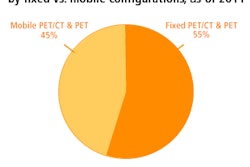Early indications are that the MRI protocol is time-efficient and can be used for primary staging of head and neck cancer in a whole-body PET/MRI system with equivalent diagnostic capability as PET/CT.
"In our opinion, PET/MRI might have potential advantages in local staging of head and neck cancer patients due to the superb soft-tissue contrast of MRI compared to CT," said presenter Dr. Matthias Eiber from the Institute of Radiology at Technische Universität München. "In addition, in CT sometimes heavy beam artifacts due to tooth implants can be observed, which in most cases doesn't pose a real problem for MRI. This is an additional advantage for the anatomical delineation of the tumor."
Using a clinical 3-tesla MRI system, 20 patients with untreated head and neck cancer staged with FDG-PET/CT underwent a dedicated MR protocol for the neck. In addition, a whole-body Dixon MR sequence was applied for attenuation correction on the hybrid PET/MRI system.
With the MRI protocol, mean imaging time was 44:17 minutes, ranging from 35:44 to 54:58.
Although not statistically significant, a combination of MRI and PET performed best in delineating the primary tumor compared with CT, MR, and PET/CT, the authors noted.
In patients with artifacts from dental implants, the MRI protocol also offered better detail of the primary tumor. PET/CT with MRI and PET performed slightly better than CT and MR for assessing lymph node metastases.
Eiber stressed that the study being presented at RSNA 2011 involves patients being scanned separately on a PET/CT scanner and subsequently on an MRI system with consecutive image fusion.



















